Lasting N-terminal phosphorylation of c-Jun and activation of c-Jun N-terminal kinases after neuronal injury
- PMID: 9651196
- PMCID: PMC6793486
- DOI: 10.1523/JNEUROSCI.18-14-05124.1998
Lasting N-terminal phosphorylation of c-Jun and activation of c-Jun N-terminal kinases after neuronal injury
Abstract
Transcription factor c-Jun is proposed to control neuronal cell death and survival, but its activation by N-terminal phosphorylation and the underlying activity of the c-Jun N-terminal kinases (JNKs) remain to be elucidated in the adult mammalian brain. We generated a polyclonal antiserum that specifically recognizes c-Jun phosphorylated at its serine 73 (S73) residue after UV irradiation of 3T3 cells. Disruption of the c-jun locus in 3T3 cells abolished this reaction, and retransfection of the human c-jun at the c-jun-/- background restored it. The phospho-c-Jun antiserum was used to visualize N-terminally phosphorylated c-Jun in the adult rat brain with cellular resolution. Prolonged c-Jun S73 phosphorylation was detected in affected neurons up to 5 d after transient occlusion of medial cerebral artery or up to 50 d after transection of central nerve fiber tracts. After cerebral ischemia-reperfusion, phosphorylation of c-Jun was linked with induced expression of Fas-ligand (APO-1, CD95-ligand), whose gene is a putative c-Jun/AP-1 target, and with terminal deoxynucleotidyl transferase-mediated biotinylated UTP nick end labeling (TUNEL) reactivity, a marker for apoptosis. After nerve fiber transection, however, lasting c-Jun phosphorylation occurred in axotomized neurons negative for Fas-ligand or TUNEL and regardless of degeneration or survival. In contrast to these lasting phosphorylation patterns, transient seizure activity by pentylenetetrazole provoked only a brief c-Jun phosphorylation and JNK activation. In extracts from ischemic or axotomized brain compartments, c-Jun phosphorylation correlated with enhanced long-term JNK activity, and in-gel kinase assays visualized proteins with sizes corresponding to JNK isoforms as the only c-Jun N-terminally phosphorylating enzymes. These results demonstrate that lasting c-Jun S73 phosphorylation and JNK activity are part of neuronal stress response after neurodegenerative disorders in the adult mammalian brain with Fas-ligand as a putative apoptotic effector.
Figures
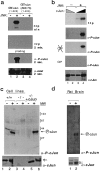
 ) or (fourth panel) native CIP (40 U/ml).Fifth panel, After final stripping, the blot was reprobed with the c-Jun antiserum (α-cJun).c, Immunodetection of phosphorylated c-Jun in immortalized 3T3 fibroblasts derived from wild-type (lanes 1, 2) or c-jun−/− mouse embryos (lanes 3, 4) (Hilberg et al., 1993) or c-jun−/−cells stably transfected with a human c-jun expression vector (lanes 5, 6), which were (+) or were not (−) UV-irradiated. The membrane was probed with the phospho-c-Jun antiserum (α-P-cJun) or c-Jun antibody (α-cJun). d, Detection of phosphorylated c-Jun in nuclear cortical extracts from untreated rats (lane 1) or after ischemia with 24 hr reperfusion (lane 2) by immunoblotting with the anti-phospho-c-Jun or anti-c-Jun antiserum.
) or (fourth panel) native CIP (40 U/ml).Fifth panel, After final stripping, the blot was reprobed with the c-Jun antiserum (α-cJun).c, Immunodetection of phosphorylated c-Jun in immortalized 3T3 fibroblasts derived from wild-type (lanes 1, 2) or c-jun−/− mouse embryos (lanes 3, 4) (Hilberg et al., 1993) or c-jun−/−cells stably transfected with a human c-jun expression vector (lanes 5, 6), which were (+) or were not (−) UV-irradiated. The membrane was probed with the phospho-c-Jun antiserum (α-P-cJun) or c-Jun antibody (α-cJun). d, Detection of phosphorylated c-Jun in nuclear cortical extracts from untreated rats (lane 1) or after ischemia with 24 hr reperfusion (lane 2) by immunoblotting with the anti-phospho-c-Jun or anti-c-Jun antiserum.

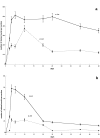
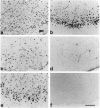
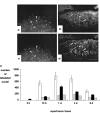


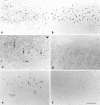
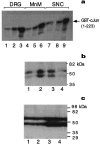
Similar articles
-
The mitochondrial toxin 3-nitropropionic acid induces striatal neurodegeneration via a c-Jun N-terminal kinase/c-Jun module.J Neurosci. 2002 Mar 15;22(6):2174-84. doi: 10.1523/JNEUROSCI.22-06-02174.2002. J Neurosci. 2002. PMID: 11896157 Free PMC article.
-
The c-Jun N-terminal protein kinase signaling pathway mediates Bax activation and subsequent neuronal apoptosis through interaction with Bim after transient focal cerebral ischemia.J Neurosci. 2004 Sep 8;24(36):7879-87. doi: 10.1523/JNEUROSCI.1745-04.2004. J Neurosci. 2004. PMID: 15356200 Free PMC article.
-
Early modifications in the expression of mitogen-activated protein kinase (MAPK/ERK), stress-activated kinases SAPK/JNK and p38, and their phosphorylated substrates following focal cerebral ischemia.Acta Neuropathol. 2003 May;105(5):425-37. doi: 10.1007/s00401-002-0661-2. Epub 2003 Jan 21. Acta Neuropathol. 2003. PMID: 12677442
-
Activation of the c-Jun transcription factor following neurodegeneration in vivo.Neurosci Lett. 2004 May 6;361(1-3):36-9. doi: 10.1016/j.neulet.2003.12.011. Neurosci Lett. 2004. PMID: 15135887 Review.
-
From JNK to pay dirt: jun kinases, their biochemistry, physiology and clinical importance.IUBMB Life. 2005 Apr-May;57(4-5):283-95. doi: 10.1080/15216540500097111. IUBMB Life. 2005. PMID: 16036612 Review.
Cited by
-
c-Jun-dependent CD95-L expression is a rate-limiting step in the induction of apoptosis by alkylating agents.Mol Cell Biol. 2000 Jan;20(2):575-82. doi: 10.1128/MCB.20.2.575-582.2000. Mol Cell Biol. 2000. PMID: 10611236 Free PMC article.
-
A critical role of neural-specific JNK3 for ischemic apoptosis.Proc Natl Acad Sci U S A. 2003 Dec 9;100(25):15184-9. doi: 10.1073/pnas.2336254100. Epub 2003 Dec 1. Proc Natl Acad Sci U S A. 2003. PMID: 14657393 Free PMC article.
-
Activation of mitogen-activated protein kinases after transient forebrain ischemia in gerbil hippocampus.J Neurosci. 2000 Jun 15;20(12):4506-14. doi: 10.1523/JNEUROSCI.20-12-04506.2000. J Neurosci. 2000. PMID: 10844020 Free PMC article.
-
Regulation of apoptotic and inflammatory cell signaling in cerebral ischemia: the complex roles of heat shock protein 70.Anesthesiology. 2008 Aug;109(2):339-48. doi: 10.1097/ALN.0b013e31817f4ce0. Anesthesiology. 2008. PMID: 18648242 Free PMC article. Review.
-
Increased operant responding for ethanol in male C57BL/6J mice: specific regulation by the ERK1/2, but not JNK, MAP kinase pathway.Psychopharmacology (Berl). 2009 May;204(1):135-47. doi: 10.1007/s00213-008-1444-9. Epub 2009 Jan 6. Psychopharmacology (Berl). 2009. PMID: 19125235 Free PMC article.
References
-
- Anderson AJ, Cummings BJ, Cotman CW. Increased immunoreactivity for Jun- and Fos-related proteins in Alzheimer’s disease: association with pathology. Exp Neurol. 1994;125:286–295. - PubMed
-
- Arias J, Alberts AS, Brindle P, Claret FX, Smeal T, Karin M, Feramisco J, Montminy M. Activation of cAMP and mitogen responsive genes relies on a common nuclear factor. Nature. 1994;370:226–229. - PubMed
-
- Asanuma M, Nishibayashi S, Kondo Y, Iwata E, Tsuda M, Ogawa N. Effects of single cyclosporin A pretreatment on pentylenetetrazol-induced convulsion and on TRE-binding activity in the rat brain. Mol Brain Res. 1995;33:29–36. - PubMed
-
- Blottner D, Herdegen T. Neuroprotective FGF-2 down-regulates the c-Jun transcription factor in axotomized sympathetic preganglionic neurons of adult rats. Neuroscience. 1997;82:283–292. - PubMed
Publication types
MeSH terms
Substances
Grants and funding
LinkOut - more resources
Full Text Sources
Other Literature Sources
Molecular Biology Databases
Research Materials
Miscellaneous
